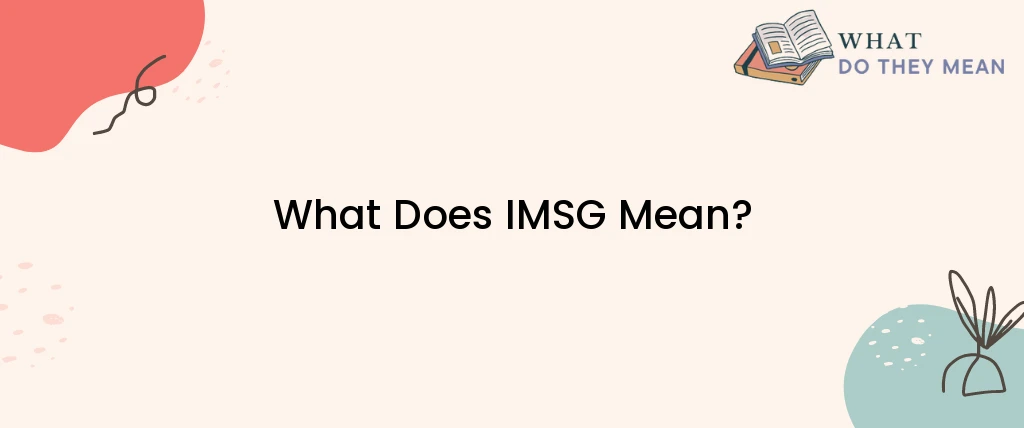IMSG is an acronym that stands for “Instant Message”. In the world of technology and communication, instant messaging has become a popular and convenient way for individuals to communicate with each other in real time. This type of communication has been around for several decades, but it has evolved and improved over the years with advancements in technology.
What is Instant Messaging?
Instant messaging (IM) refers to a type of real-time text-based communication that is sent and received over the internet. It’s essentially like having a conversation with someone online, in real time. The messages are typically sent and received through a computer program or mobile app, and they appear in a conversational style, just like a regular conversation between two people.
IM has become a popular form of communication because it is fast, convenient, and allows individuals to communicate with each other instantly. With instant messaging, there is no need to wait for a response like you would with an email or text message. The messages are delivered instantly, and you can carry on a conversation in real time.
History of Instant Messaging:
The concept of instant messaging can be traced back to the 1960s when computer scientists first began working on systems that would allow people to communicate in real time over the internet. However, it wasn’t until the 1990s that the first instant messaging program was introduced. The first instant messaging program was called IRC (Internet Relay Chat), and it was created for use by computer programmers.
Over the years, instant messaging has evolved and improved. In the late 1990s, AOL introduced its instant messaging program, AOL Instant Messenger (AIM), which quickly became popular and widely used. AIM was followed by other instant messaging programs such as MSN Messenger and Yahoo! Messenger.
With the advent of smartphones, instant messaging has become even more popular and widely used. Today, there are many instant messaging apps available for both iOS and Android devices, and many of these apps allow users to send text messages, make voice and video calls, and share photos and files.
Benefits of Instant Messaging:
There are many benefits to using instant messaging, both for personal and professional purposes. Some of the key benefits include:
- Real-time communication: Instant messaging allows individuals to communicate in real time, which is much faster and more efficient than other forms of communication such as email or text messaging.
- Convenience: With instant messaging, you can communicate with someone instantly, no matter where you are. This is especially useful for individuals who are on the go or who are not near a computer.
- Cost-effective: Instant messaging is a cost-effective way to communicate, as it is often free or very low-cost.
- Accessibility: Instant messaging apps are widely available and can be used on many different devices, including computers, smartphones, and tablets.
- Productivity: Instant messaging can help to increase productivity by allowing individuals to communicate and collaborate on projects in real time.
You may also like: What Does JW Mean In Text?
Types of Instant Messaging:
There are several different types of instant messaging, including:
- Text-based instant messaging: This is the most basic and widely used form of instant messaging. It allows individuals to send text-based messages in real time.
- Voice and video calls: Many instant messaging apps now allow users to make voice and video calls, which is a great way to communicate with someone face-to-face without being in the same physical location.
- Group messaging: Some instant messaging apps allow users to communicate with multiple individuals in a group chat. This is a convenient way to communicate and collaborate with a group of people.
- File sharing: Some instant messaging apps allow users to share files, such as photos, documents, and videos. This is a great way to collaborate on projects and share information.
Conclusion:
Instant messaging has come a long way since its inception in the 1960s. Today, it is a popular and widely used form of communication that offers many benefits, including real-time communication, convenience, cost-effectiveness, accessibility, and increased productivity. With the continued advancement of technology, it’s likely that instant messaging will continue to evolve and improve, making it even more useful and convenient for individuals and organizations.

As a researcher, I am curious and driven by the pursuit of knowledge. I approach my work with a critical eye, carefully evaluating sources and methods to ensure that my findings are accurate and reliable. Whether delving into scientific studies, historical records, or cutting-edge technologies, I am always seeking to expand my understanding and make new discoveries. I am dedicated to uncovering new insights and finding solutions to complex problems, and am driven by a passion for uncovering the truth.


